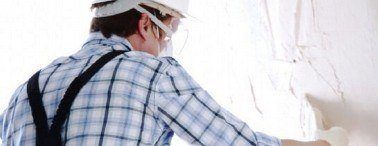
Plaster as an interior wallcovering has been around since the Egyptians used it over 4,000 years ago (but Biblical scholars say that the ancient city of Jericho had plaster walls in 7,000 BC). In fact some of these walls are still in great shape today. The plastering trade reached prominence during the 13th Century in London when, after a huge fire devastated the city, the king decreed that all homes must have plastered walls to prevent fires. This plaster was mostly limestone and sand and took almost 2 weeks to harden. In the 19th Century the fast-setting gypsum powder became more plentiful and began to replace lime.
Drywall
Drywall replaced plastering in the early 1950's because of its ease of use, time to install and, as a result, lower expense. In fact a drywall crew could finish a new home in 2 days whereas it took a team of plasterers over a week for the same amount of wall coverage. The drawback of drywall is that it is not as durable as plaster. The soft gypsum sandwiched by paper shells will not resist much of a force before it dents. Plaster, on the other hand, is more like concrete because water produces a chemical reaction which bonds the molecules together into a hard mass.
Veneer Plastering
Plastering is becoming popular again with discriminating home builders who want a quality wall. However instead of using wooden lathes the basic platform is actually a form of gypsum board which is installed like drywall but then the entire surface is plastered over. Here are the list of materials for veneer plastering and the tools required are similar if not the same as many drywall tools:
Blue Board
In North America gypsum board manufacturers color the outside surface of the panel to denote their use. Regular drywall board is white or gray, moisture and mold resistant types for kitchens and bathrooms are green and board designed for plastering is blue.
This is a gypsum-cored panel like a drywall sheet only the sheet wrapping is different. On drywall board the binding surface is paper while on blue board there is a two-ply coating. The first is an absorbent material designed to hold the plaster while the second underlayment is waterproofed to prevent moisture from the plastering process from being absorbed into the gypsum core. Because the entire board is being covered with a wet mixture the board could warp or sag before drying so the protective inner layer prevents this from happening. Plaster can be applied to regular drywall but first the surface has to be painted with a special orange-colored compound.
Plaster
Like the plaster of old this is a gypsum powder which remains soft after drying. This sets it apart from concrete and allows it to be shaped although it was never intended for any loadbearing activities.
The Process of Veneer Plastering
A plasterer is more of an artist that a tradesperson. With a keen eye he or she has to put on a coat of the mixture that is absolutely perfect so that the walls are straight and the corners sharp. This is the same with veneer plastering. After the blue board is installed the seams are taped and plastered, as with normal drywalling, but here is where the similarity ends because there is no waiting for the joints to dry.
Right after this operation the entire wall surface is coated with 1/8" of plaster in a smooth series of motions with a special trowel. The plasterer will go back over the surface to trowel out any imperfections. Usually a second coat can be applied the next day but some only do one. This is where the special treatment comes in.
In many cases the paster is stippled or given other designs and left as is. In other instances the plaster can be colored. But a big asset of veneer plastering is that is provides a great base for painting. Whereas regular drywall has paper and paint, which interrupt the patina of the wall, plaster is one continuous surface and the paint goes on evenly.
Cost of Veneer Plastering
As you might expect, the cost of veneer plaster is more expensive, about 30% higher, if you can find plastering contractors in your area. This also depends on how many top coats are put down. However, if the moldings are going to be plastered, it will be a great finishing touch to the look you want.
Posted by: TrustedPros




